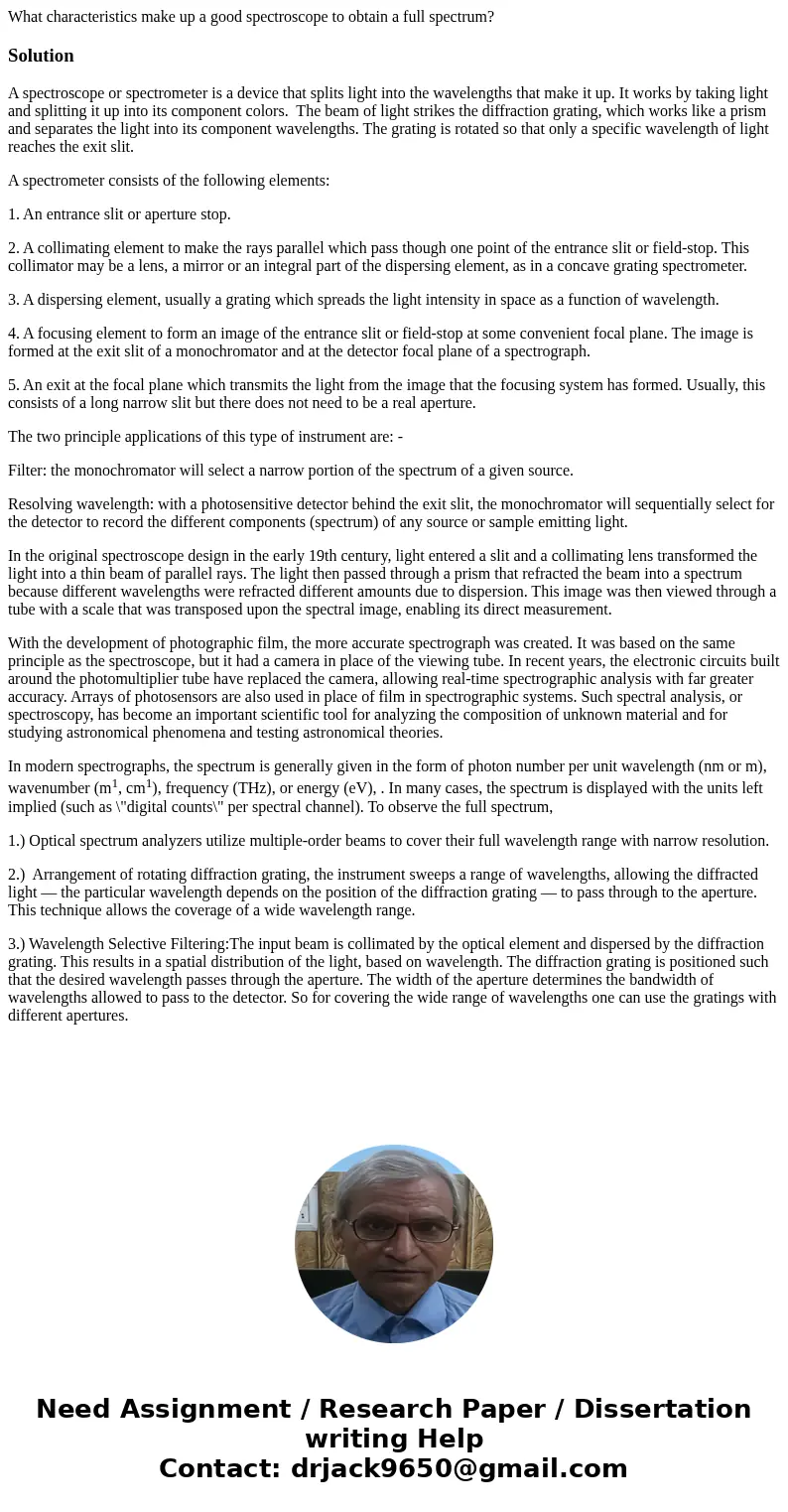What characteristics make up a good spectroscope to obtain a
What characteristics make up a good spectroscope to obtain a full spectrum?
Solution
A spectroscope or spectrometer is a device that splits light into the wavelengths that make it up. It works by taking light and splitting it up into its component colors. The beam of light strikes the diffraction grating, which works like a prism and separates the light into its component wavelengths. The grating is rotated so that only a specific wavelength of light reaches the exit slit.
A spectrometer consists of the following elements:
1. An entrance slit or aperture stop.
2. A collimating element to make the rays parallel which pass though one point of the entrance slit or field-stop. This collimator may be a lens, a mirror or an integral part of the dispersing element, as in a concave grating spectrometer.
3. A dispersing element, usually a grating which spreads the light intensity in space as a function of wavelength.
4. A focusing element to form an image of the entrance slit or field-stop at some convenient focal plane. The image is formed at the exit slit of a monochromator and at the detector focal plane of a spectrograph.
5. An exit at the focal plane which transmits the light from the image that the focusing system has formed. Usually, this consists of a long narrow slit but there does not need to be a real aperture.
The two principle applications of this type of instrument are: -
Filter: the monochromator will select a narrow portion of the spectrum of a given source.
Resolving wavelength: with a photosensitive detector behind the exit slit, the monochromator will sequentially select for the detector to record the different components (spectrum) of any source or sample emitting light.
In the original spectroscope design in the early 19th century, light entered a slit and a collimating lens transformed the light into a thin beam of parallel rays. The light then passed through a prism that refracted the beam into a spectrum because different wavelengths were refracted different amounts due to dispersion. This image was then viewed through a tube with a scale that was transposed upon the spectral image, enabling its direct measurement.
With the development of photographic film, the more accurate spectrograph was created. It was based on the same principle as the spectroscope, but it had a camera in place of the viewing tube. In recent years, the electronic circuits built around the photomultiplier tube have replaced the camera, allowing real-time spectrographic analysis with far greater accuracy. Arrays of photosensors are also used in place of film in spectrographic systems. Such spectral analysis, or spectroscopy, has become an important scientific tool for analyzing the composition of unknown material and for studying astronomical phenomena and testing astronomical theories.
In modern spectrographs, the spectrum is generally given in the form of photon number per unit wavelength (nm or m), wavenumber (m1, cm1), frequency (THz), or energy (eV), . In many cases, the spectrum is displayed with the units left implied (such as \"digital counts\" per spectral channel). To observe the full spectrum,
1.) Optical spectrum analyzers utilize multiple-order beams to cover their full wavelength range with narrow resolution.
2.) Arrangement of rotating diffraction grating, the instrument sweeps a range of wavelengths, allowing the diffracted light — the particular wavelength depends on the position of the diffraction grating — to pass through to the aperture. This technique allows the coverage of a wide wavelength range.
3.) Wavelength Selective Filtering:The input beam is collimated by the optical element and dispersed by the diffraction grating. This results in a spatial distribution of the light, based on wavelength. The diffraction grating is positioned such that the desired wavelength passes through the aperture. The width of the aperture determines the bandwidth of wavelengths allowed to pass to the detector. So for covering the wide range of wavelengths one can use the gratings with different apertures.

 Homework Sourse
Homework Sourse